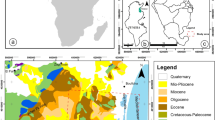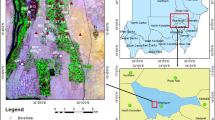Abstract
Poor understanding of groundwater resources of the basement environment constitutes a barrier to sustainability of current potable groundwater-based supply initiatives in sub-Sahara Africa. This study assesses the influence of aquifer characteristics on groundwater yield potential and the consequent impact on water supply in Osun Drainage Basin within the basement complex area of southwestern Nigeria. Aquifer thickness, longitudinal unit conductance, hydraulic conductivity (K) and transmissivity (T) were derived from the interpretation results of 500 spatially referenced vertical electrical sounding data and subjected to descriptive and inferential statistics. Descriptive statistics show that aquifer thickness is generally low in most part of the study area with the exception of few locations where overburden thickness exceeds 50 m. Delineated aquifers have the capacity to absorb and retain water but with less ability to release the water, as indicated by low mean K (1.6 × 10−4 m/s). Only 1.4% of the aquifers have medium relative K (10−3 m/s), while the remaining 98.65% have low to very low relative K (≤ 10−4 m/s). Computed low mean T (6.2 × 10−3 m2/s) suggests low groundwater yield potential for the study basin. Currently, groundwater resources could only meet 32.7% of the household water demand of the study area and the coverage would reduce to 27.2% in the decade 2021–2030. Therefore, there is an urgent need to focus on surface water development given the fact that annual rainfall is high enough to sustain pipe-borne water supply schemes in the study basin.





Similar content being viewed by others
References
Adagunodo TA, Luning S, Adeleke AM, Omidiora JO, Aizebeokhai AP, Oyeyemi KD, Hammed OS (2018) Evaluation of 0 ≤ M ≤ 8 earthquake data sets in African-Asian region during 1966–2015. Data Brief 17:588–603
Akinluyi FO (2013) Integration of remotely sensed and geophysical data in groundwater potential evaluation of the basement complex Terrain of Ondo State, Southwestern Nigeria. Dissertation, Department of Geology, Obafemi Awolowo University, Ile-Ife, Nigeria
Akinwumiju AS (2015) GIS-based integrated approach to groundwater potential assessment of Osun Drainage Basin, Southwestern Nigeria. Dissertation, Institute of Ecology and Environmental Science, Obafemi Awolowo University, Ile-Ife, Nigeria
Archie GE (1942) The electrical resistivity log for determining some reservoir characteristics. Trans AIME Petrol Br 146:54–62
Ashaolu ED, Omotosho O (2015) Assessment of static water level and overburden pattern for sustainable groundwater development and management in Ilorin City, Nigeria. Malays J Soc Sp 11(9):1–11
Ayolabi EA, Olatinsu OB, Badmus BS (2009) Groundwater potential evaluation using electrical resistivity method in typical basement complex area of Nigeria. J Sci Technol 29(1):52–65
Bayewu OO, Oloruntola MO, Mosuro GO, Laniyan TA, Ariyo SO, Fatoba JO (2017) Geophysical evaluation of groundwater potential in part of Southwestern Basement Complex terrain of Nigeria. Appl Water Sci 7:4615–4632
Bayowa OG, Olorunfemi MO, Akinluyi FO, Ademilua OL (2014) Integration of hydro-geophysical and Remote Sensing data in the assessment of groundwater potential of the basement complex terrain of Ekiti State, Southwestern Nigeria. Ife J Sci 16(3):353–363
Bear J (1979) Hydraulics of groundwater. McGraw-Hill, USA
Bhattacharya PK, Patra HP (1968) Direct current geo-electric sounding. Elsevier, Amsterdam, pp 3–11
Bonsor HC, Oates N, Chilton PJ, Carter RC, Casey V, MacDonald AM, Calow R, Alowo R, Wilson P, Tumutungire M, Bennie M (2015) A hidden crisis: strengthening the evidence base on the sustainability of rural groundwater supplies-results from pilot study in Uganda. BGS Report OR/15/019. Natural Environmental Research Council (NERC), British Geological Survey
Butler DK (2005) Near surface geophysics. society of exploration geophysicists. Oklahoma, USA. p 758. ISBN:978-1-56080-130-6
Dhakate R, Singh VS (2005) Estimation of Hydraulic Parameters from Surface Geophysical Methods, Kaliapani Ultramafic Complex, Orissa, India. J Environ Hydrol 13(12):1–11
Driscoll FG (1989) Groundwater and wells. Johnson Screens, Minnesota. ISBN 0-9616456-0-1
Ehinola OA, Opoola AO, Adesokan HA (2006) Empirical analysis of electromagneticprofiles for groundwater prospecting in rural areas of Ibadan, Southwestern Nigeria. Hydrogeol J 14:613–624
Food and Agriculture Organization (2008) Renewable internal freshwater resource in Nigeria. FAO Aquastat. Database
Freeze RA, Cherry JA (1979) Groundwater. Prentice-Hall, New Jersey, p 624. ISBN 0-13-365312-9
Gastwirth JL, Gel YR, Miao W (2009) The impact of Levene’s test of equality of variances on statistical theory and practice. Stat Sci 24(3):343–360
Gelhar LW, Welty C, Rehfeldt KR (1992) A critical review of data on field-scale dispersion in aquifers. Water Resour Res 28(7):1955–1974
Ghosh DP (1971) Inverse filter coefficients for the computation of apparent resistivity standard curves for a horizontally stratified earth. Geophys Prospect 19:769–775
Gibbons RD, Bhaumik DK, Aryal S (2009) Statistical methods for groundwater monitoring, 2nd edn. Wiley, Oxford, p 41
Hamil L, Bell FG (1980) Groundwater resource development. Burlington, Butterworks, p 346
Heath RC (1983) Basic groundwater hydrology. U. S. Geological Survey. Water supply paper 2220, p 86
Jayeoba A, Oladunjoye MA (2013) Hydro-geophysical evaluation of groundwater potential in hard rock terrain of Southwestern Nigeria. RMZ-Mater Geoenviron 60:271–285
Keller GV, Frischnecht FC (1966) Electrical methods in geophysical prospecting. Pergamon, Oxford, p 523
Kelly W (1977) Geoelectric sounding for estimating aquifer hydraulic conductivity. Ground Water 15(6):420–424. https://doi.org/10.1111/j.1745-6584.1977.tb03189.x
Lockwood H, Bakalian A, Wakeman W (2003) Assessing sustainability in rural water supply: the role of follow-up support to communities. Literature review and desk review of rural water supply and sanitation project documents. Interim Product. World Bank. Washington DC, p 54
MacDonald AM, Calow RC (2009) Developing groundwater for secure rural water supplies in Africa. Desalination 248:546–556
Macdonald DMJ, Thompson DM, Herbert R (1995) Sustainability of yield from wells and boreholes in crystalline basement aquifers. British Geological Survey Technical Report WC/95/50
MacDonald M, Burleigh J, Burgess W (1999) Estimating transmissivity from surface resistivity soundings: an example from the Thames Gravels. Q J Eng Geol 32(2):199–205. https://doi.org/10.1144/GSL.QJEG.1999.032.P2.09
Marsily G (1986) Quantitative hydrology. Academic, New York
Mazac O, Kelly WE, Landa I (1985) A hydrogeophysical model for relations between electrical and hydraulic properties of aquifers. J Hydrol 79(1):1–19
Mogaji KA (2016) Geoelectrical parameter based multivariate regression borehole yield model for predicting aquifer yield in managing groundwater resources sustainability. J Taibah Univ Sci. https://doi.org/10.1016/j.jtusci.2015.12.006
Mogaji KA, Olayanju GM, Oladapo MI (2011) Geophysical evaluation of rock type impact on aquifer characterization in the Basement Complex Areas of Ondo State, Southwestern Nigeria: geo-electric Assessment and Geographic Information Systems (GIS) Approach. Int J Water Resour Environ Eng 3(4):77–86
Niwas S, Singhal DC (1985) Aquifer transmissivity of porous media from resistivity data. J Hydrol 82(1–2):143–153
Nordstokke DW, Zumbo BD (2007) A cautionary tale about Levene’s tests for equal variances. J Educ Res Policy Stud 7(1):1–14
Odeyemi IB (1981) Review of orogenic events in the basement complex of Nigeria, West Africa. Geol Rundschau 70(3):897–909
Oladapo MI, Mohammed MZ, Adeoye OO, Adetola BA (2004) Geoelectrical investigation of the Ondo State Housing Corporation Estate, Ijapo Akure, Southwestern Nigeria. J Min Geol 40(1):41–48
Oladapo MI, Adeoye-Oladapo OO, Mogaji KA (2009) Hydrogeophysical study of the groundwater potential of Ilara-Mokin, Southwestern Nigeria. Glob J Pure Appl Sci 15(2):195–204
Olayinka AI, Akpan E, Magbagbeola OA (1997) Geoelectric sounding for estimating aquifer potential in the crystalline basement area around Shaki, Southwest Nigeria. Water Resour 8(1&2):71–81
Olorunfemi MO (1990) The hydrogeological implication of topographic variation with overburden thickness in basement complex area of Southwestern Nigeria. J Min Geol 26(1):1–15
Olorunfemi MO (2009) Groundwater exploration, borehole site selection and optimum drilling depth in basement complex Terrain, Special Publication Series 1 (ISSN 0795-6495). Nigerian Association of Hydrogeologists, p 20
Olorunfemi MO, Fasuyi SA (1993) Aquifer types and the geoelectric/hydrologic characteristics of part of the central basement terrain of Nigeria (Niger State). J Afr Earth Sc 16:309–317
Olorunfemi MO, Okhue EJ (1992) Hyrogeologic and geologic significance of a geoelectric survey at Ile–Ife, Nigeria. J Min Geol 28:242–350
Olorunfemi MO, Olorunniwo MA (1985) Geo-electric parameter and aquifer characteristics of some part of Southwestern Nigeria. Geol Appl Indrogeol 20:99–109
Olorunfemi MO, Olarewaju VO, Alade O (1991) On the electrical anisotropy and groundwater yield in a Basement Complex area of Southwestern Nigeria. J Afr Earth Sci 12(3):467–472
Olorunfemi MO, Ojo JS, Akintunde OM (1999) Hydrogeophysical evaluation of the groundwater potential of Akure metropolis, Southwestern Nigeria. J Min Geol 3(2):207–228
Olorunfemi MO, Afolayan JF, Afolabi O (2004) Geoelectric/electromagnetic VLF survey for groundwater in a Basement Terrain: a case Study. Ife J Sci 6(1):74–78
Olorunniwo MA, Olorunfemi MO (1987) Geophysical investigations for groundwater in Precambrian terrains: a case history from Ikare, Southwestern Nigeria. J Afr Earth Sci 6(6):787–796
Omair A (2014) Understanding the process of statistical methods for effective data analysis. J Health Spec 2(3):100–104
Osinowo OO, Olayinka I (2012) Very low frequency electromagnetic (VLF-EM) and electrical resistivity (ER) investigation for groundwater potential evaluation in a complex geological terrain around the Ijebu-Ode transition zone, Southwestern Nigeria. J Geophys Eng 9:374–394
Oyinloye AO (2011) Geology and geotectonic setting of the basement complex rocks in Southwestern Nigeria: implications on provenance and evolution. In: Imran AD (ed) Earth and environmental sciences, In Tech. ISBN: 978-953-307-468-9. http://www.intechopen.com/books/earth-and-environmental-sciences/geology-and-geotectonic-setting-of-the-basement-complex-rocks-in-south-western-nigeria-implications. Accessed 21 Jan 2017
Rahaman MA (1976) Review of the basement geology of Southwestern Nigeria. J Min Geol 36(1):9–18
Rietveld LC, Haarhoff J, Jagals J (2009) A tool for technical assessment of rural water supply systems in South Africa. Phys Chem Earth 34:43–49
RWSN (2009) Handpump data, selected countries in sub-Sahara Africa. http://www.rwsn.ch. Accessed 10 Oct 2018
Schluter T, Trauth MH (2008) Geological Atlas of Africa: with notes on statigraphy, tectonics, economic geology, geohazards, geosites and geoscientific education of each country. Springer, Berlin (ISBN:3540763732, 9783540763734)
Sharma PU (1997) Environmental and engineering geophysics. Cambridge University Press, Cambridge, p 475
Shevnin V, Delgado-Rodriguez O, Mousatov A, Ryjov A (2006) Estimation of hydraulic conductivity on clay content in soil determined from resistivity data. Geofis Int 43(3):195–207
Taylor CD, Schulz KJ, Doebrich JL, Orris GJ, Denning PD, Kirschbaum MJ (2009) Geology and nonfuel mineral deposits of Africa and the Middle East. Open-File Report, United States Geological Survey, p 246
Telford WM, Geldart LP, Sheriff RE, Keys DA (1990) Applied geophysics, 2nd edn. Cambridge University Press, Cambridge, p 214
United States Agency for International Development (2010) Nigeria: water and sanitation profile. http://www.usaid.gov. Accessed 10 Sep 2018
White IF (1986) An assessment of geophysical method applied to basement aquifer studies in Masvingo Province, Zimbabwe. Commonw Sci Council Tech Pap 273(11):14–32
WHO/UNICEF (2013) Progress on sanitation and drinking water, p 40. http://www.wssinfo.org. Accessed 2 Aug 2018
WHO/UNICEF (2017) Progress on drinking water, sanitation and hygiene: 2017 update and SDG baselines, Geneva: World Health Organization (WHO) and the United Nations Children’s Fund (UNICEF), 2017. Licence: CC BY-NC-SA 3.0 IGO
World Health Organization (2005) Minimum water quantity needed for domestic uses. WHO/SEARO technical notes for emergencies, technical note no. 9. Prepared by Water, Engineering and Development Centre, Loughborough University, Leicestershire, UK
Wright CP (1992) The hydrogeology of crystalline basement aquifers in Africa. In: Wright CP, Burgess WC (eds) Hydrogeology of crystalline basement aquifer in Africa. Geological Society of London Special Publication, London, pp 1–27
Yazicigil H, Sendlein VA (1982) Surface geophysical techniques in groundwater monitoring, part II. Groundw Monit Remed 2:56–62
Acknowledgements
The author is grateful to the Department of Geology of Obafemi Awolowo University, Ile-Ife, Nigeria, for providing the geophysical data. Profound gratitude also goes to Prof. M. O. Olorunfemi for providing background information on the theory and practice of electrical methods in potential field geophysics. The reviewers are also acknowledged for their constructive comments and suggestions.
Author information
Authors and Affiliations
Corresponding author
Additional information
Publisher's Note
Springer Nature remains neutral with regard to jurisdictional claims in published maps and institutional affiliations.
Rights and permissions
About this article
Cite this article
Akinwumiju, A.S. Hydrogeological characteristics of crystalline rock aquifers: implication on sustainable water supply in the basement complex terrain of southwestern Nigeria. Sustain. Water Resour. Manag. 6, 26 (2020). https://doi.org/10.1007/s40899-020-00381-z
Received:
Accepted:
Published:
DOI: https://doi.org/10.1007/s40899-020-00381-z




